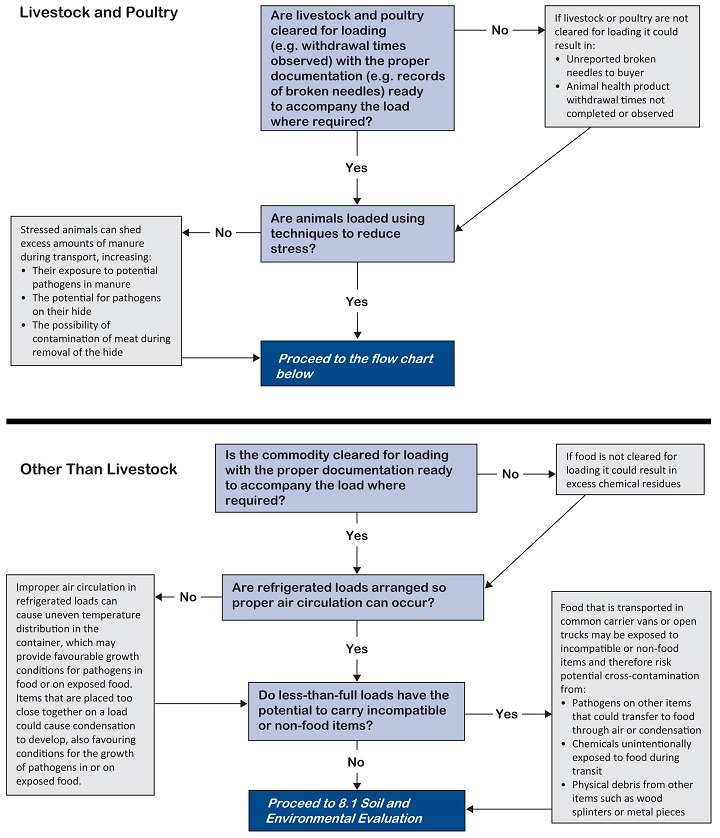Shipping - 7.4 Loading and unloading
If food, livestock or inputs are not properly loaded or unloaded, damage, contamination or spoilage can occur.
This good agricultural practice applies to all farms.
What needs to be done
Load and unload food, livestock/poultry and inputs in a manner that prevents damage, spoilage or contamination from occurring.
How to do it
Food and inputs
- Assemble each load in a way that prevents the final products from being crushed, broken and/or scattered during transport
- When products are being loaded into refrigerated transport vehicles, arrange them to allow for circulation of cold air
- Do not load fresh produce with incompatible inputs (for example, pesticides or fuels)
Livestock and poultry
Take steps to minimize the amount of stomach fill and the amount of manure on hides/feather for livestock and poultry that are shipped for slaughter. To do this, consider:
- The amount of bedding used during housing and transportation
- Feed withdrawal periods prior to shipping
As stressed animals shed more pathogens, reduce the amount of stress during loading and unloading by:
- Using ramps
- Handling animals in a calm, quiet manner
- Discouraging the use of electric prods
Do not load downer or non-ambulatory (not able to walk) animals. See the Canadian Food Inspection Agency requirements for downer animals:
- Make sure pre-harvest intervals and withdrawal times have been met before loading and shipping.
- When a needle has been broken and remains in the animal, write and tell the information to the next stage of production
In general
- Prior notification of shipments to the next stage may be required. Ensure the appropriate documentation requested by the buyer accompanies the load
- Keep the information required for traceability of the product that has been shipped, and be prepared to share it if necessary. Learn more about the required data to record
If you have an audit
Be prepared for the auditor to:
- Review production records (for example, pesticide use records, animal health product use records) to verify shipping requirements are met
- Review shipping documentation where required by the buyer
- Observe loading and unloading occurring during the audit
Laws and regulations
There are few laws that directly impact on food safety regulating loading and unloading practices for agricultural production. However, there are various laws that prohibit the transport of certain plants or animals or require permits. These are often part of disease management or control regulations. As many of these do not have a human food safety implication, such as plant diseases, they are therefore out of the scope of this page.
The Health of Animals Regulations (Canada) Part XII defines conditions for the humane transport of all animals in Canada, including appropriate conditions for loading and unloading of animals. S. 138 (2) prohibits loading or transporting an animal that, by reason of infirmity, illness, injury, fatigue or any other cause, cannot be transported without undue suffering during the expected journey.
The Milk Industry Standards Regulation, Reg. 464/81, s. 25 (8) under the Milk Industry Act specifies every milk house has a hose port that is at least 15 centimetres above the inside floor or the outside ground level, whichever is higher, projects through the wall at the loading side, is accessible to the outlet valve of the holding tank, and has an outside self-closing cover.
The Agricultural Produce Grading Act, R.S.B.C. 1996, c. 11, Shell Egg Grading Regulation, Reg. 105/78, s. 3 (2) and (3) provide that no person shall sell, offer for sale, or transport ungraded eggs other than a producer transporting eggs produced on his farm to an egg station or an egg product station, or with the prior written approval of a producer, an egg station transporting ungraded eggs received by it from the producer to an egg product station. S. 3 (3) states ungraded eggs must be clearly identified by the receiver at an egg station or egg product station.
The Integrated Pest Management Act, S.B.C. 2003, c. 58, Integrated Pest Management Regulation, Reg. 604/04, 33 (2) specifies that a person who transports or causes or allows the transport of a pesticide must ensure that the pesticide is secured and transported in a manner that prevents the contamination of food or drink intended for animal or human consumption.

